by Calculated Risk on 5/06/2019 07:27:00 PM
Monday, May 06, 2019
Tuesday: Job Openings
From Matthew Graham at Mortgage News Daily: Lowest Mortgage Rates in a Month
Mortgage rates dropped noticeably this morning as financial markets opened sharply changed from Friday's latest levels thanks to Trump trade tweets over the weekend. The stock market dropped to its lowest levels in several weeks before bouncing back as the day progressed. As money flew out of stocks, it found a safe haven in the bond market. Mortgage rates are most directly affected by the bond market, and when demand for bonds increases, rates fall.Tuesday:
The average lender was offering its best rates in roughly a month this morning. You'd have to go back to April 10th to see anything lower. [30YR FIXED - 4.25%]
emphasis added
• At 10:00 AM ET, Job Openings and Labor Turnover Survey for March from the BLS.
• At 10:00 AM, Corelogic House Price index for February.
• At 3:00 PM, Consumer Credit from the Federal Reserve.
Update: Framing Lumber Prices Down 35% Year-over-year
by Calculated Risk on 5/06/2019 03:23:00 PM
Here is another monthly update on framing lumber prices. Lumber prices declined from the record highs in early 2018, and are now down about 35% year-over-year.
This graph shows two measures of lumber prices: 1) Framing Lumber from Random Lengths through April 26, 2019 (via NAHB), and 2) CME framing futures.

Right now Random Lengths prices are down 31% from a year ago, and CME futures are down 40% year-over-year.
There is a seasonal pattern for lumber prices, and usually prices will increase in the Spring, and peak around May, and then bottom around October or November - although there is quite a bit of seasonal variability.
When will I make another "Big" economic call?
by Calculated Risk on 5/06/2019 12:11:00 PM
A short note: Over the years, I've made several significant economic calls. For example, I predicted a recession in 2007, a recovery in 2009 (link is first in a series of posts), the top for housing prices in early 2006 and the bottom for housing prices in early 2012. I do not have a crystal ball, and I've missed some calls - but by watching the data closely, I've been pretty lucky overall.
Sometimes people ask me when I'll make another call. I don't know; I'm very data dependent!
But I was wondering if these count? Back in December 2015, I wrote The Endless Parade of Recession Calls. I concluded:
Looking at the economic data, the odds of a recession in 2016 are very low (extremely unlikely in my view). Someday I'll make another recession call, but I'm not even on recession watch now.That was correct. And earlier this year I wrote an update to that post.
My view now: a recession in 2019 is very unlikely. I'm still not on recession watch!So far that looks correct too.
Someday I'll make another "Big" call, but I don't know when.
How to Report the Monthly Employment Number excluding Temporary Census Hiring
by Calculated Risk on 5/06/2019 10:29:00 AM
The Census Bureau will soon start hiring temporary workers for the 2020 Census. Temporary hiring will really increase in March, April and May of 2020, and then the jobs will finish in a few months. These are real jobs - frequently second jobs, or taken by seniors and students - but they will only last a few months.
Since these are temporary, and only happen every ten years with the decennial Census, it makes sense to adjust the headline monthly Current Employment Statistics (CES) by Census hiring to determine the underlying employment trend.
The correct adjustment method is to take the headline number and subtract the change in the number of Census 2020 temporary and intermittent workers. The BLS reports the number of Census temporary workers here: Census 2020 temporary and intermittent workers and Federal government employment
As an example, in May 2010, the Census hired 411 thousand temporary workers. The BLS reported (since revised)
"Total nonfarm payroll employment grew by 431,000 in May, reflecting the hiring of 411,000 temporary employees to work on Census 2010, the U.S. Bureau of Labor Statistics reported today."So the underlying trend was +20,000 jobs in May 2010 (as originally reported).
For June 2010, the number of temporary Census hires declined by 225,000. The BLS reported
"Total nonfarm payroll employment declined by 125,000 in June, and the unemployment rate edged down to 9.5 percent, the U.S. Bureau of Labor Statistics reported today. The decline in payroll employment reflected a decrease (-225,000) in the number of temporary employees working on Census 2010."So the underlying trend was +100,000.
Some readers will notice that this is mixing SA and NSA data! Usually that is not appropriate, but in this special case, based on the methods used by the BLS, this is correct.
I checked with the BLS, and they agree in this situation it is correct. Here is my question (back in March 2010) and the BLS response:
9:34 Michele Walker (BLS-CES) -So starting soon (as hiring ramps up), the correct way to report the headline number is ex-Census.
Submitted via email from Bill: Hi. The headline payroll number is seasonally adjusted, and the hiring for the 2010 Census is NSA. How would you suggest adjusting for the 2010 Census hiring to determine the underlying trend?
Thanks for your question Bill.
There is an adjustment made for the 2010 Census. Before seasonally adjusting the estimates, BLS makes a special modification so that the Census workers do not influence the calculation of the seasonal factors. Specifically, BLS subtracts the Census workers from the not-seasonally adjusted estimates before running seasonal adjustment using X-12. After the estimates have been seasonally adjusted, BLS adds the Census workers to the seasonally adjusted totals. Therefore, to determine the underlying trend of the total nonfarm (TNF) employment estimates (minus the Census workers), simply subtract the Census employment from the seasonally adjusted TNF estimate.
BTW, it is widely reported that there have been 103 consecutive months with positive job growth (a record). However, if you use the ex-Census numbers, it is 110 consecutive months! The job streak started during the decennial Census, but was masked by the temporary Census layoffs. As an example, the BLS reported a negative 64,000 jobs in September 2010, however the number of temporary Census workers declined by 76,000 that month, so ex-Census the number of jobs added in September 2010 was 12,000.
Black Knight Mortgage Monitor for March: National Delinquency Rate Nearing Record Low
by Calculated Risk on 5/06/2019 09:01:00 AM
Black Knight released their Mortgage Monitor report for March today. According to Black Knight, 3.65% of mortgages were delinquent in March, down from 3.73% in March 2018. Black Knight also reported that 0.51% of mortgages were in the foreclosure process, down from 0.63% a year ago.
This gives a total of 4.16% delinquent or in foreclosure.
Press Release: Black Knight: Servicers Retained Just 18% of Customers Post-Refinance in Q1 2019, a 13-Year Low; Slight Rate Increase Reduces Refinanceable Population by 1 Million
Today, the Data & Analytics division of Black Knight, Inc. released its latest Mortgage Monitor Report, based upon the company’s industry-leading mortgage performance, housing and public records datasets. This month, by leveraging its McDash loan-level mortgage performance data in combination with public property records, Black Knight undertook an analysis of mortgage servicer retention rates by looking at consecutive mortgages on a single property before and after a refinance transaction. As Black Knight’s Data & Analytics Division President Ben Graboske explained, retention rates – the share of borrowers who remain with their prior servicer post-refinance – have reached record lows, creating serious challenges in an ever more competitive marketplace.
“In Q1 2019, fewer than one in five homeowners remained with their prior mortgage servicer after refinancing their first lien,” said Graboske. “That is the lowest retention rate we’ve seen since Black Knight began tracking the metric in 2005. Anyone in this industry can tell you that customer retention is key – not only to success, but to survival. The challenge is that everyone is competing for a piece of a shrinking refinance market, the size of which is incredibly rate-sensitive, and therefore volatile in its make-up. Just a month ago, we were reporting that recent rate reductions had swelled the population of eligible refinance candidates by more than half in a single week after hitting a multi-year low just a few months before. Then, with just a slight increase in the 30-year fixed rate – less than one-eighth of a point – 1 million homeowners lost their rate incentive to refinance – almost 20% of the total eligible market.
“This is critical, because refinances driven by a homeowner seeking to reduce their rate or term have always been servicers’ ‘bread and butter’ when it comes to customer retention. Offering lower rates to qualified existing customers is a good, and relatively simple, way to retain their business. Unfortunately, the market has shifted dramatically away from such rate/term refinances. In fact, nearly 80% of 2018 refinances involved the customer pulling equity out of their home – and more than two-thirds of those raised their interest rate to do so. Retention battles are no longer won – or lost – based on interest rates alone. A simple ‘in the money analysis’ doesn’t provide the insight necessary to retain customers and can’t take the place of accurately identifying borrowers who are likely to refinance and offering them the correct product. Rather, understanding equity position – and the willingness to utilize that equity – is key to accurately identifying attrition risk and reaching out to retain that business.”
emphasis added
 Click on graph for larger image.
Click on graph for larger image.Here is a graph from the Mortgage Monitor that shows the Q1 90 day National delinquency inventory over time.
From Black Knight:
• 90-day delinquencies are down 4% YTD in 2019 and have fallen below 500K for the first time since 2006The second graph shows foreclosure sales over time:
...
• With the national delinquency rate just 0.17% above the all-time low in March 2005, we may well be on pace to a new record low if external impacts on performance subside

• Foreclosure sales fell below 39K in Q1 2019 for the first time on record dating back to 2000There is much more in the mortgage monitor.
• Q1 2019's foreclosure sales represented roughly 14% of starting foreclosure inventory
• Declines in foreclosure sales have broadly kept pace with the overall decline in active foreclosure inventory nationwide
…
• Florida led all states with 3.5K foreclosure sales for the quarter followed by New York and New Jersey at 2.4K each
Sunday, May 05, 2019
Sunday Night Futures
by Calculated Risk on 5/05/2019 08:59:00 PM
Weekend:
• Schedule for Week of May 5, 2019
Monday:
• No major economic releases scheduled.
From CNBC: Pre-Market Data and Bloomberg futures: S&P 500 are down 46 and DOW futures are down 469 (fair value).
Oil prices were down over the last week with WTI futures at $60.41 per barrel and Brent at $69.23 per barrel. A year ago, WTI was at $71, and Brent was at $75 - so oil prices are down 10% to 15% year-over-year.
Here is a graph from Gasbuddy.com for nationwide gasoline prices. Nationally prices are at $2.89 per gallon. A year ago prices were at $2.80 per gallon, so gasoline prices are up 9 cents per gallon year-over-year.
Public and Private Sector Payroll Jobs During Presidential Terms
by Calculated Risk on 5/05/2019 12:18:00 PM
By request, here is another update of tracking employment during Presidential terms. We frequently use Presidential terms as time markers - we could use Speaker of the House, Fed Chair, or any other marker.
NOTE: Several readers have asked if I could add a lag to these graphs (obviously a new President has zero impact on employment for the month they are elected). But that would open a debate on the proper length of the lag, so I'll just stick to the beginning of each term.
Important: There are many differences between these periods. Overall employment was smaller in the '80s, however the participation rate was increasing in the '80s (younger population and women joining the labor force), and the participation rate is generally declining now. But these graphs give an overview of employment changes.
The first graph shows the change in private sector payroll jobs from when each president took office until the end of their term(s). Presidents Carter and George H.W. Bush only served one term.
Mr. G.W. Bush (red) took office following the bursting of the stock market bubble, and left during the bursting of the housing bubble. Mr. Obama (dark blue) took office during the financial crisis and great recession. There was also a significant recession in the early '80s right after Mr. Reagan (dark red) took office.
There was a recession towards the end of President G.H.W. Bush (light purple) term, and Mr Clinton (light blue) served for eight years without a recession.
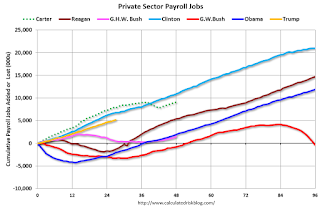
The first graph is for private employment only.
Mr. Trump is in Orange (27 months).
The employment recovery during Mr. G.W. Bush's (red) first term was sluggish, and private employment was down 821,000 jobs at the end of his first term. At the end of Mr. Bush's second term, private employment was collapsing, and there were net 382,000 private sector jobs lost during Mr. Bush's two terms.
Private sector employment increased by 20,979,000 under President Clinton (light blue), by 14,714,000 under President Reagan (dark red), 9,039,000 under President Carter (dashed green), 1,511,000 under President G.H.W. Bush (light purple), and 11,890,000 under President Obama (dark blue).
During the first 27 months of Mr. Trump's term, the economy has added 5,163,000 private sector jobs.
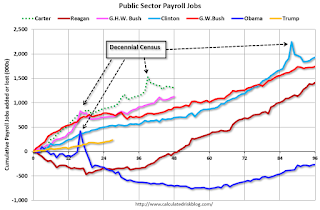
The public sector grew during Mr. Carter's term (up 1,304,000), during Mr. Reagan's terms (up 1,414,000), during Mr. G.H.W. Bush's term (up 1,127,000), during Mr. Clinton's terms (up 1,934,000), and during Mr. G.W. Bush's terms (up 1,744,000 jobs). However the public sector declined significantly while Mr. Obama was in office (down 269,000 jobs).
During the first 27 months of Mr. Trump's term, the economy has added 237,000 public sector jobs.
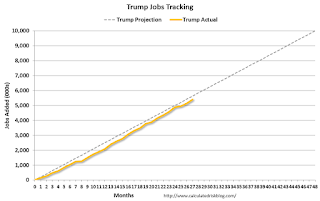
After 27 months of Mr. Trump's presidency, the economy has added 5,400,000 jobs, about 225,000 behind the projection.
Saturday, May 04, 2019
Schedule for Week of May 5, 2019
by Calculated Risk on 5/04/2019 08:11:00 AM
The key report this week is the April CPI.
No major economic releases scheduled.
 10:00 AM ET: Job Openings and Labor Turnover Survey for March from the BLS.
10:00 AM ET: Job Openings and Labor Turnover Survey for March from the BLS. This graph shows job openings (yellow line), hires (purple), Layoff, Discharges and other (red column), and Quits (light blue column) from the JOLTS.
Jobs openings increased decreased in February to 7.087 million from 7.625 million in January.
The number of job openings (yellow) were up 9% year-over-year, and Quits were up 10% year-over-year.
10:00 AM: Corelogic House Price index for February.
3:00 PM: Consumer Credit from the Federal Reserve.
7:00 AM ET: The Mortgage Bankers Association (MBA) will release the results for the mortgage purchase applications index.
8:30 AM: The initial weekly unemployment claims report will be released. The consensus is for 215 thousand initial claims, down from 230 thousand last week.
 8:30 AM: Trade Balance report for March from the Census Bureau.
8:30 AM: Trade Balance report for March from the Census Bureau. This graph shows the U.S. trade deficit, with and without petroleum, through the most recent report. The blue line is the total deficit, and the black line is the petroleum deficit, and the red line is the trade deficit ex-petroleum products.
The consensus is the trade deficit to be $50.1 billion. The U.S. trade deficit was at $49.4 Billion in February.
8:30 AM: The Producer Price Index for April from the BLS. The consensus is for a 0.2% increase in PPI, and a 0.2% increase in core PPI.
8:30 AM: The Consumer Price Index for April from the BLS. The consensus is for 0.4% increase in CPI, and a 0.2% increase in core CPI.
Friday, May 03, 2019
AAR: April Rail Carloads down 0.9% YoY, Intermodal Down 3.9% YoY
by Calculated Risk on 5/03/2019 04:27:00 PM
From the Association of American Railroads (AAR) Rail Time Indicators. Graphs and excerpts reprinted with permission.
Volumes for U.S. railroads in April 2019 were far from ideal, but they were much better than in March. Total carloads in April were down 0.9% (9,130 carloads), compared with a decline of 8.9% (93,616 carloads) in March. … The improvement in April was due partly to a return to near-normal operations in the Midwest as numerous rail lines that had been flooded were returned to service — coal and grain were especially impacted. ... Intermodal volume fell 3.9%, or 42,832 containers and trailers, in April 2019 from April 2018. That’s the third-straight monthly decline for intermodal, something that hasn’t happened since the fall of 2016.
emphasis added
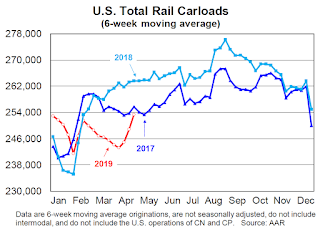 Click on graph for larger image.
Click on graph for larger image.This graph from the Rail Time Indicators report shows U.S. average weekly rail carloads (NSA). Red is 2019.
Rail carloads have been weak over the last decade due to the decline in coal shipments.
Rail traffic in April 2019 won’t win any prizes, but it could’ve been worse.
Total U.S. rail carloads were 1.04 million in April 2019, down 0.9%, or 9,130 carloads, from April 2018. That’s the third straight year-over-year monthly decline for total carloads, but it’s much better than the 8.9% decline in March and the 2.7% decline in February
For the first four months of 2019, total U.S. carloads were down 2.5%, or 109,930 carloads, from the first four months of 2018.
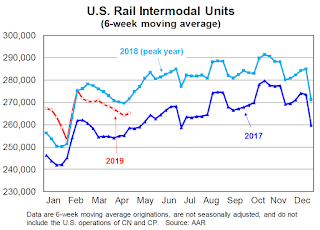 The second graph is for intermodal traffic (using intermodal or shipping containers):
The second graph is for intermodal traffic (using intermodal or shipping containers):For the first four months of 2019, intermodal volume was down 1.4%, or 62,724 units, from the same period in 2019 … This year had a few moving pieces that aren’t always there — e.g., imports being rushed ashore late last year to beat scheduled tariff increases at the start of this year; intermodal lane rationalizations in some areas; the aforementioned flooding; and an economy that’s been even harder than usual to read.
Comments on April Employment Report
by Calculated Risk on 5/03/2019 03:14:00 PM
The headline jobs number at 263 thousand for April was above consensus expectations of 180 thousand, and the previous two months were revised up 16 thousand, combined. The unemployment rate declined to 3.6%. Overall this was a strong report.
Earlier: April Employment Report: 263,000 Jobs Added, 3.6% Unemployment Rate
In April, the year-over-year employment change was 2.620 million jobs. That is solid year-over-year growth.
Average Hourly Earnings
Wage growth was close to expectations. From the BLS:
"In April, average hourly earnings for all employees on private nonfarm payrolls rose by 6 cents to $27.77. Over the year, average hourly earnings have increased by 3.2 percent."
 This graph is based on “Average Hourly Earnings” from the Current Employment Statistics (CES) (aka "Establishment") monthly employment report. Note: There are also two quarterly sources for earnings data: 1) “Hourly Compensation,” from the BLS’s Productivity and Costs; and 2) the Employment Cost Index which includes wage/salary and benefit compensation.
This graph is based on “Average Hourly Earnings” from the Current Employment Statistics (CES) (aka "Establishment") monthly employment report. Note: There are also two quarterly sources for earnings data: 1) “Hourly Compensation,” from the BLS’s Productivity and Costs; and 2) the Employment Cost Index which includes wage/salary and benefit compensation.The graph shows the nominal year-over-year change in "Average Hourly Earnings" for all private employees. Nominal wage growth was at 3.2% YoY in April.
Wage growth has generally been trending up.
Prime (25 to 54 Years Old) Participation
 Since the overall participation rate has declined due to cyclical (recession) and demographic (aging population, younger people staying in school) reasons, here is the employment-population ratio for the key working age group: 25 to 54 years old.
Since the overall participation rate has declined due to cyclical (recession) and demographic (aging population, younger people staying in school) reasons, here is the employment-population ratio for the key working age group: 25 to 54 years old.In the earlier period the participation rate for this group was trending up as women joined the labor force. Since the early '90s, the participation rate moved more sideways, with a downward drift starting around '00 - and with ups and downs related to the business cycle.
The 25 to 54 participation rate was declined in April at 82.2% from 82.5% in March, and the 25 to 54 employment population ratio was decreased to 79.7%.
Part Time for Economic Reasons
 From the BLS report:
From the BLS report:"The number of persons employed part time for economic reasons (sometimes referred to as involuntary part-time workers) was little changed at 4.7 million in April. These individuals, who would have preferred full-time employment, were working part time because their hours had been reduced or because they were unable to find full-time jobs."The number of persons working part time for economic reasons increased in April to 4.654 million from 4.499 million in March. The number of persons working part time for economic reason has been generally trending down.
These workers are included in the alternate measure of labor underutilization (U-6) that was unchanged at 7.3% in April.
Unemployed over 26 Weeks
 This graph shows the number of workers unemployed for 27 weeks or more.
This graph shows the number of workers unemployed for 27 weeks or more. According to the BLS, there are 1.230 million workers who have been unemployed for more than 26 weeks and still want a job. This was down from 1.305 million in March.
Summary:
The headline jobs number was above expectations, and the previous two months were revised up slightly. The headline unemployment rate declined to 3.6%.
This was a strong jobs report. The economy added 820 thousand jobs through April 2019, down from 879 thousand jobs during the same period in 2018. So it appears job growth has slowed somewhat, but is still solid.
The decline in the participation rate lowered the unemployment rate. Note that sometime soon the overall participation rate will start another steady decline due to demographic factors. The overall participation rate has been moving sideways for several years, as the expansion has offset the demographics factors.


